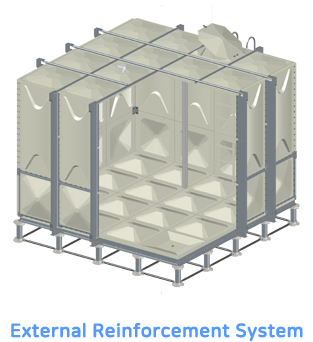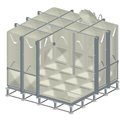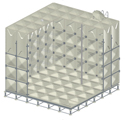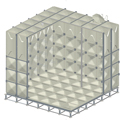1. Based on design external force
The external forces used in the structural design of water tanks are as shown in Table 1 below, and they must be designed by considering all combinations of stresses generated.
Table 1. Combination of design external forces (loads)
| Types of stresses | Expected state/condition | Weight of internal water (F) | Dead load (G) | Snow load (S) | Live load (P) | Earthquake load (K) | Wind load (W) | Remark |
|---|---|---|---|---|---|---|---|---|
| Long-run | At all times | ○ | ○ | Footnote 2) | - | - | - | - |
| Short-run | When loading | ○ | ○ | Footnote 2) | ○ | - | - | - |
| In case of a storm | ○ | ○ | - | - | - | ○ | Footnote 1) | |
| In case of an earthquake | ○ | ○ | Footnote 2) | - | ○ | - | - | |
| In case of snow | ○ | ○ | ○ | - | - | - | - |
Footnote 1) It is deemed that there is no internal water when reviewing buckling due to an external force by a storm, conduction or fixed parts of the basic frame.
Footnote 2) When installing in a region with heavy snow, the snow load is regarded and added as a Long-run load, or as a Short-run load when loading. In case of an earthquake, combine the load and consider a suitable snow load for the installed area.
2. Overview of each load
2-1. Earthquake load (K)
2-1-1. Common horizontal seismic coefficient (KH)
Horizontal seismic coefficient, KH, is a coefficient determined by the area in which a water tank is installed, the importance of the water tank, building structure, installed floor, etc. Typically, its formula is as follows.
· KH = β ∗ KFH ≤ 2.0
· KFH=I ∗ K1 ∗ Z ∗ KOH
※ β: Acceleration response magnification ratio of the water tank during an earthquake / KFH : Horizontal seismic coefficient on the nth floor / I : Strength coefficient of building use (importance factor of a building or water tank) / K1 : Coefficient depending on the floor on which the water tank is installed / Z : Zone coefficient/ KOH : Horizontal seismic coefficient applied on the 1st floor (=0.4)
1) Acceleration response magnification ratio of the water tank (β) - Acceleration response magnification ratio (β) is related to the changing pressure of the internal water due to an earthquake and expressed as follows depending on the floor on which the water tank is installed.
| Floor on which the water tank is installed | β |
|---|---|
| Underground or 1st floor | 2.0 |
| Rooftop floor | 1.5 |
2) Strength coefficient of building use (I)
| Category | β |
|---|---|
| When shock resistance is particularly emphasized | 0.7 |
| When shock resistance is emphasized | 0.5 |
| Others | 0.3 |
3) Coefficient depending on the installed floor (K1)
| Category | β | Remark |
|---|---|---|
| Underground or 1st floor | 1.0 | ∗ ai = ( N+2- i ) / N+1 ※ N: Number of ground floors of a building (rooftop floor is N+1) i: Floor on which the water tank is installed |
| Rooftop floor | 2.5 | |
| Middle floors | 1/ ai ≤ 2.5 |
4) Zone coefficient (Z) - The coefficient for consideration of regional differences of earthquake activities, and applies a value of Z=0.7-1.0.
2-1-2. Standard horizontal seismic coefficient for water tank design (KH)
※ I ∗z= 0.5(I=0.7) / I ∗z= 1.0(I=1.5)
| Upper floors Rooftop and loft | 0.7 | 1.5 |
|---|---|---|
| Middle floors | 0.5 | 1.0 |
| Underground 1st and ground floors | 0.5 | 1.0 |
∗ KH is set as 1/3, 1.0 and 3 of 1.5, which have been rounded up.
2-2. Weight of internal water (F)
Hydrostatic pressure by the internal water is treated as a Long-run load and calculated by the following formula.
Ps = 0.1 X y
※ Ps: Hydrostatic pressure (kgf/cm²) / y : Distance from the water surface (m)
However, the maximum level of the internal water shall be the height from the floor of the water tank to the level of overflow.
2-3. Snow load (S)
Snow load on the ceiling of a water tank is treated as a Short-run load, and the snow load for standard design shall be
S = 60kg/m².
For reference, it is 1) 2kg/m²/cm for common regions, and 2) 3kg/m²/cm for regions with heavy snow.
2-4. Live load (P)
Live load (P) is the weight of persons on the ceiling, assumed as a concentrated load and treated as a Short-run load. (P=80kg/panel)
2-5. Fixed load (G)
Fixed load (G) is the weight of a water tank’s main body and treated as a Long-run load.
2-6. Wind load (W)
For a water tank installed outdoors, the wind load shall be considered and is treated as a Short-run load.
| Location | Wind pressure, p (kgf/m²) | Wind load, D (kgf) | Remark | ||
|---|---|---|---|---|---|
| Installed location | Installed location | ||||
| Ground | Rooftop | Ground | Rooftop | ||
| Side of water tank | 96 | 225 | 144 × A | 385 × A | ∗ A : Area on which the wind pressure force is exerted |
| Ceiling of water tank | -96 | -225 | |||
3. Structural design standard
Structural design of a water tank basically obeys the following formula [Allowable stress = Threshold / Safety factor ≥ Applied stress] For thresholds, the following two types are considered.
3-1. Based on damage of materials
1) Permanent deformation: Based on the stress at the proportional limit point on a stress-strain curve
2) Fracture strength: SMC is difficult to define a proportional limit stress, thus the ultimate stress as the fracture strength is employed.
3-2.Based on the stiffness as a structure (deformation, buckling, etc.): Considering the elastic modulus of SMC
4. Safety factor
1) Safety factor for fracture strength of SMC material (F₁) : F₁ = 2.2
2) Safety factor in case there is an issue with the elastic modulus of SMC material (F₂) : F₂ = 1.87 (Safety factor of reinforcing structural steel and materials other than SMC is set as F₂= 2.0.)
5. Threshold
For common properties of SMC as shown in Figure 3-1, the degree of deterioration by the changes of SMC in the next 15 years is small so 60-70% of the initial static characteristic value (at room temperature) was applied as the threshold (strength), and, for permanent loads such as hydrostatic pressure and fixed load that are applied at all times, a safety factor that is 1.5 times greater (than that of a temporary load) was additionally multiplied.
6. Allowable stress (design stress)
6-1. Allowable stress and elastic modulus of SMC
| Fracture strength | Unit | Initial characteristic value (at roomtemperature) | Threshold considering 15 years of service life | Allowable stress | |
|---|---|---|---|---|---|
| Temporary load(∗1/2.2) | Permanent load(∗1/2.2∗1.5) | ||||
| Tensile strength | kgf/mm² | 10 | (∗0.7) 7.0 | 3.18 | 2.12 |
| Flexural strength | ‥ | 16 | (∗0.6) 9.6 | 4.36 | 2.91 |
| Elastic modulus | - | - | - | - | - |
| Tensile modulus | kgf/mm² | 900 | (∗0.8) 720 | - | - |
| Flexural modulus | ‥ | 1,200 | (∗0.8) 960 | - | - |
| Poisson's ratio | - | 0.3 | 0.3 | - | - |
6-2. Allowable stress and elastic modulus of structural steel
| Fracture strength | Unit | Allowable stress | |
|---|---|---|---|
| Temporary load | Permanent load | ||
| Tensile/compressive strength | kgf/mm² | 24 | 16 |
| Flexural strength | ‥ | 24 | 16 |
| Shear strength | ‥ | 13.5 | 9 |
| Elastic modulus | kgf/mm² | 900 | (∗0.8) 720 |
| Young’s modulus (E) | kgf/mm² | 21,000 | 21,000 |
| Poisson’s ratio | - | 0.3 | 0.3 |

 Facebook
Facebook




